


Yes! Dreams definitely do come true. I’m a believer. And you would be a believer, too, if you were standing in my shoes right about now. At this particular moment, my shoes happen to be standing on a slab of dusty, clay-crusted, wind-blown dirt out in the scorching desert badlands of Maricopa, Arizona. It’s hot, of course, as it usually is here. The sun is scalding my skin, and the sand that the brisk wind is kicking up is sticking to the sweat beads on my face, and running into my eyes. It’s extremely irritating, and wiping them dry with the sleeve of my dirty t-shirt doesn’t seem to be helping my vision very much.
This pity party might not seem all that impressive to you… but wait just a second, because it gets better. My toes are pointing directly into the depths of a massive ditch complex that’s about eight feet deep, and must easily measure at least a hundred feet long (if not more), with long, mellow walls, and a humongous hip off to my right. Better yet: there’s nobody around for miles to even notice that I’m standing here, let alone to kick me out of the raging fun times that I’m about to enjoy. Pinch me quick, buddy, because I must be dreaming this up. It absolutely, positively cannot get any better than this. I wipe my stinging eyes dry one last time, and roll straight in to the time of my life.

Heaven exists, kids. You just have to get out there, and find it for yourself. Ditch, Maricopa, Arizona.
The adventures are still out there on the horizon somewhere, just waiting to be discovered. The trick is to dedicate yourself to seeking them out, and living them as thoroughly as possible. It doesn’t take much, really; a reliable econobubble, a micro-camper, and a full tank of gas can get you remarkably far in life. “You’ll never know until you go”; that’s a truism that never fades, no matter how far our beloved technology pushes us forward. Unfortunately for us, the real outcome of our underwhelming technological progress these days is that we spend far more time sitting on our fat asses than ever, going nowhere at all, living vicariously through a handheld screen in a lowest-common-denominator, mass-manufactured “reality” that, ironically, is not at all real. It’s a two-dimensional existence of emptiness, a faux facade of life. My goal this summer, more than anything else, is to unplug from the virtual reality of our wireless world, and to go experience real-reality, as it was meant to be experienced.

Rawhide Western Town, Chandler, Arizona
As always, I decided to take the dirty and dusty road far less traveled in order to free myself from this modern technological prison that most of us are more than happy to chain ourselves to, and immerse ourselves in. Desert retirement oases like Maricopa, and sprawling agricultural tracts like Casa Grande probably don’t show up on the radar of too many touring skateboarders, which is precisely why I picked them as my next targets of opportunity; there was a pretty solid chance that I’d be skating something along the way that very few skaters, if any, had ever seen before. Let alone, skated. The allure of virgin concrete is what ultimately led me down this long and lonely desert byway, just a couple hours south of Phoenix’s suburban hell. As always, my good friends at Concrete Disciples led me toward the skateparks, while Free Campsites and Roadside America were instrumental in filling in the gaps with interesting suggestions for extremely adventurous, non-skating diversions along the way. My imaginitive whimsy guided the steering wheel all along my itinerary, as it usually does. No matter how pre-planned the adventures are, there’s always plenty of room for deviation and discovery along the way.
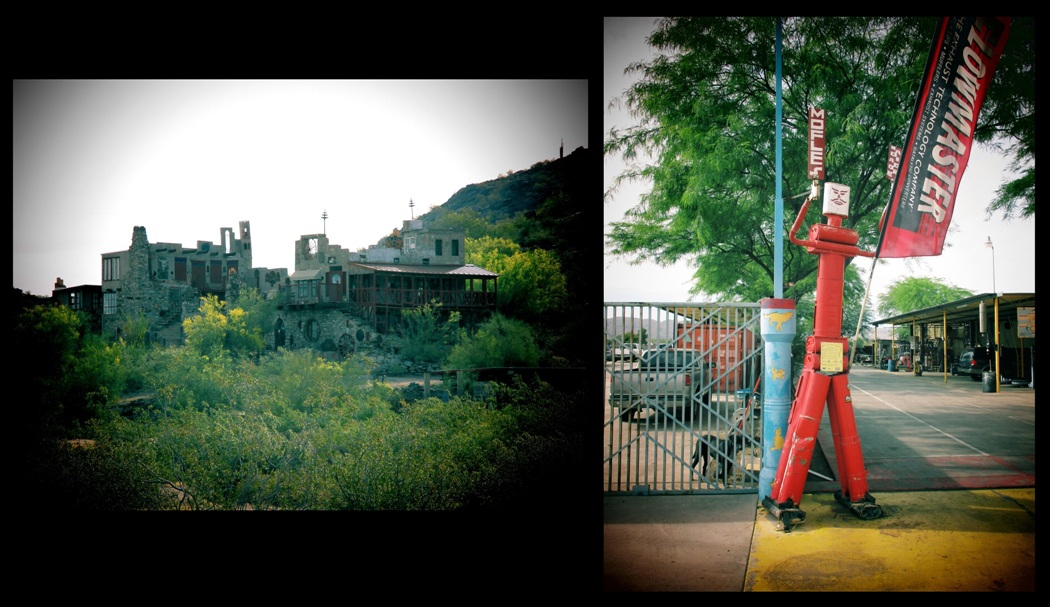
Left: Mystery Castle. Right: Moffles Auto Parts Man. Both: Phoenix, Arizona
Copper Sky Skatepark in Maricopa, strangely enough, is remarkably similar to Cesar Chavez Skatepark back in Phoenix, which I just skated earlier this morning to warm up the ‘ol muscle bubbles a bit before my long drive into the desert. It has a very “street plaza” aesthetic and feel to it, with a few dozen well-designed and excellently-executed, hybrid “urban” obstacles efficiently packed into it’s rather diminutive space. It’s clean, clever, and functional; a skilled street-skating urchin could easily have hours of fun here. But for a bowlriding fellow with a Santa Cruz Bevel under his feet, it’s a bit lacking. There is one line, however, that a dedicated dinosaur (like me) can thoroughly enjoy. It happens to be frontside for a regular footer (like me), and culminates at a five-foot-high, tightly-transitioned quarterpipe with real-deal pool coping on top. That’s a rare treat that I almost never seem to find at most “street plaza” parks, so I’m thinking that I’m a pretty lucky chump today.
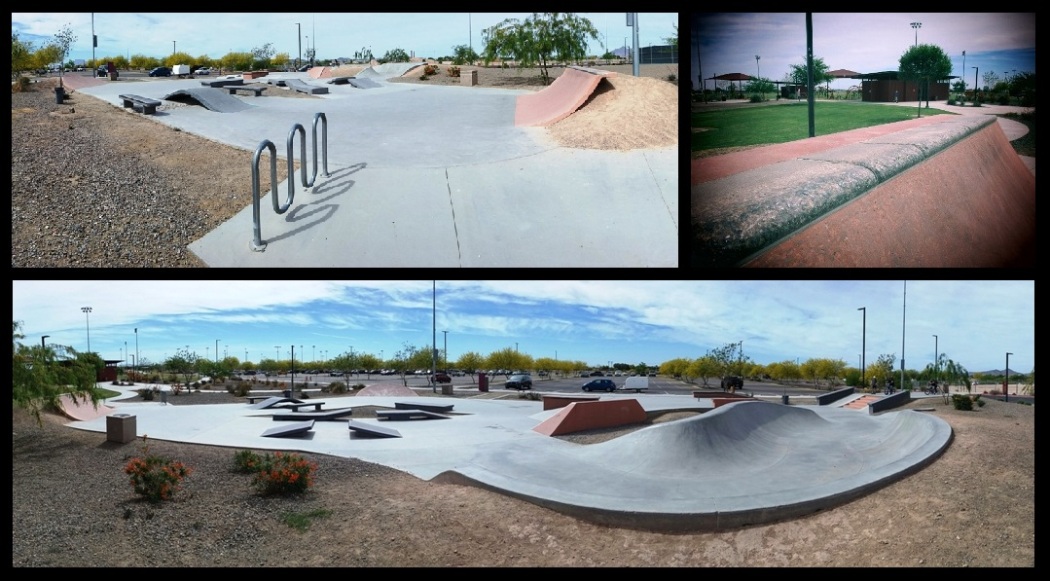
Copper Sky Skate Plaza, Maricopa, Arizona. Note the coping gnar. Bark!
Thankfully, that good luck stays solidly in effect through my first frontside grind, right when I needed it the most. You’ve never heard an Indy 215 bark as loud on a frontside grind as mine just did; it was so startling that the screeching sound itself almost pitched me straight off my board, and right onto my elbow. Somehow, my back foot forced the truck through the gritty aggregate, reeled it in, and rode it out in a squat, my Vans high tops barely clinging to the deep-dish concave of my trustiest pig. Little did I realize just how much damage years of BMX-peg abuse can do to concrete coping. My good fortune frankly astounds me on a fairly regular basis. But after closer inspection of the coping that nearly killed me, I decided that it might be best not to push my luck any further than I already have today.
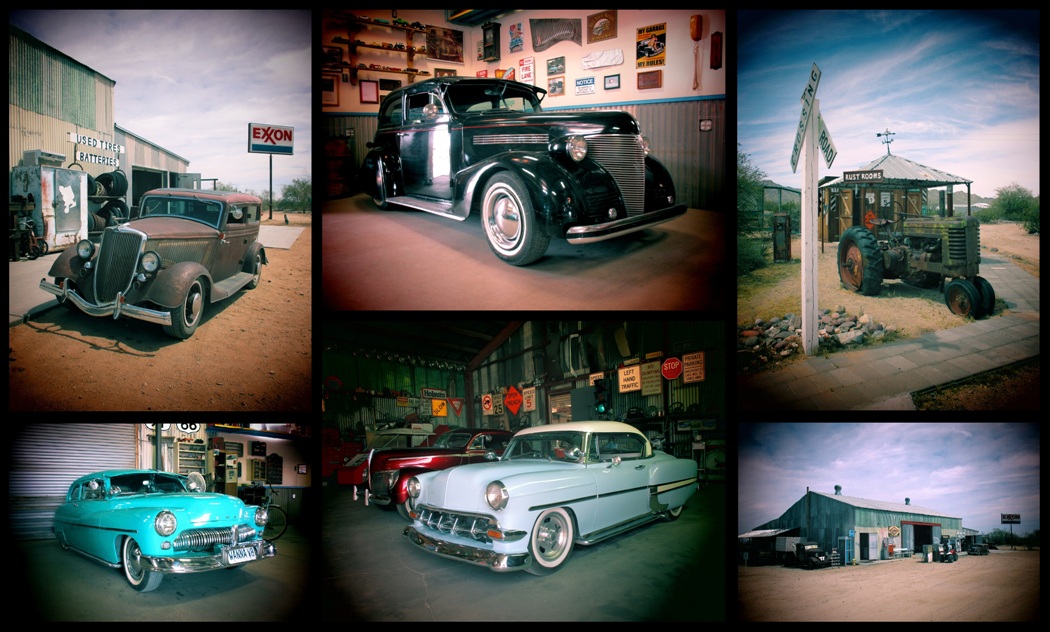
Dwarf Car Museum, Maricopa, Arizona. Note that the car at the lower left is barely taller than the bicycle parked beside it.
Roadside America has been extremely kind to me as of late. The Moffles Auto Parts Man (a mascot made entirely out of junk) was impressive enough, in a “gee whiz” sort of way, while The Mystery Castle (a residence made entirely out of junk) really took junk art to a whole new level. But hands down, the Dwarf Car Museum in Maricopa featuring 5/8ths scale, fully-functioning little hand-built automobiles (made out of junk) really took the prize of the day today. The brainchild of hobbyist Ernie Adams, the dwarf cars started as affordable little dirt-track race cars for the amateur racing enthusiast. Later, Ernie started building “cruising” dwarfs for himself to enjoy, as a fun way to whittle away his retirement years. Each car is completely hand-crafted, and can take upwards of 10,000 hours each to construct. They’re not for sale, never have been, and never will be; Ernie still owns every Dwarf car he’s ever built, and he still parks them in the giant steel building behind his house. The museum, like most museums, has a very explicit “hands off” policy… but if you get to the museum on a slow day when Ernie’s in a generous mood, you just might be able to sit inside one of the Dwarves and check it out for yourself. If you’re still a disbelieving sort of doubting Thomas, he might even be more than happy to fire one up, and let the little headers do the rest of the talking. Ernie’s an amazingly talented and creative specimen of a human being. I’m glad I spent a couple of hours with him today, learning all about his inspiring little car-creations.
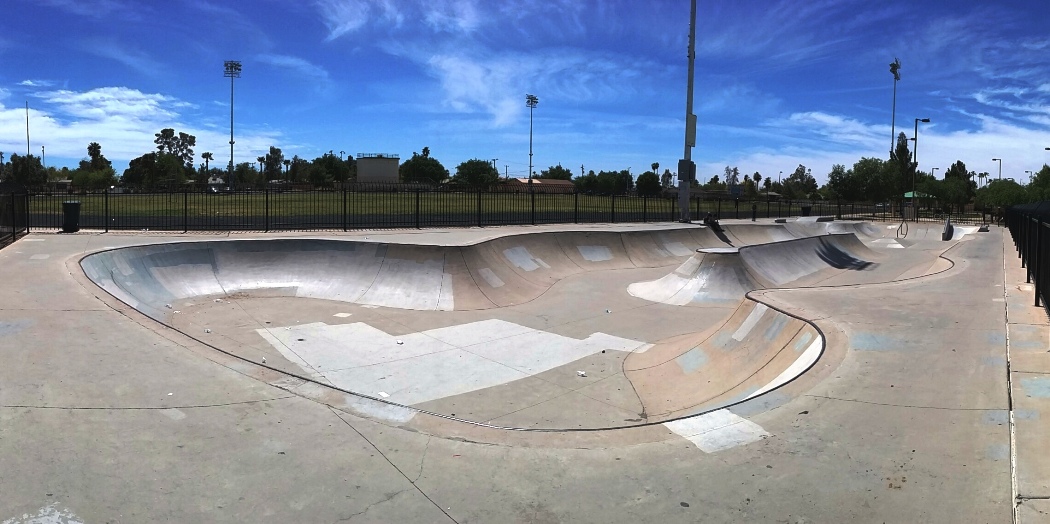

Velocity Skatepark (in Carr McNatt Park), Casa Grande, Arizona
Some skateparks really do defy rhyme or reason. The smaller the city, the more mysterious the aims and the ends seem to be. I’m at Casa Grande’s kink-sink of a skatepark bowl… a generally fun, if slightly sketchy skatepark that sits directly beside a far more popular set of soccer fields that are hosting a healthy contingent of hispanics this fine and sunny afternoon. The intermittent screams of soccer joy are wafting across the bowl, as I stand near the shallower end of the snaking run, scratching what few hairs are left on my head. There’s a handrail… a very steep, and very intimidating handrail at that… that starts at the foot of a steel picket fence, and ends at the sloping wall of a small pyramid. How you’re supposed to get on to, or off of this handrail without killing yourself is an absolute mystery to me. There’s no discernable runup, and there’s certainly no clear runout anywhere in sight. But the kink-sink bowl is enjoyable enough, with it’s expansive control joints and extremely irregular coping that either sticks out way too far, or doesn’t stick out at all. It’s not a “purely enjoyable form of fun”, per se… but the steep challenge of skating it, and skating it semi-competently, is a form of “fun” in of itself. If you’re not the type of chap that can appreciate an “extremely challenging brand of fun”, then being a road dog probably isn’t the skateboarding life for you. Even the three sullen scooter kids that were here when I arrived have moved on to the greener pastures next door, where soccer moms, dads, and kids are squealing and screeching an afternoon of soccer summer fun away.
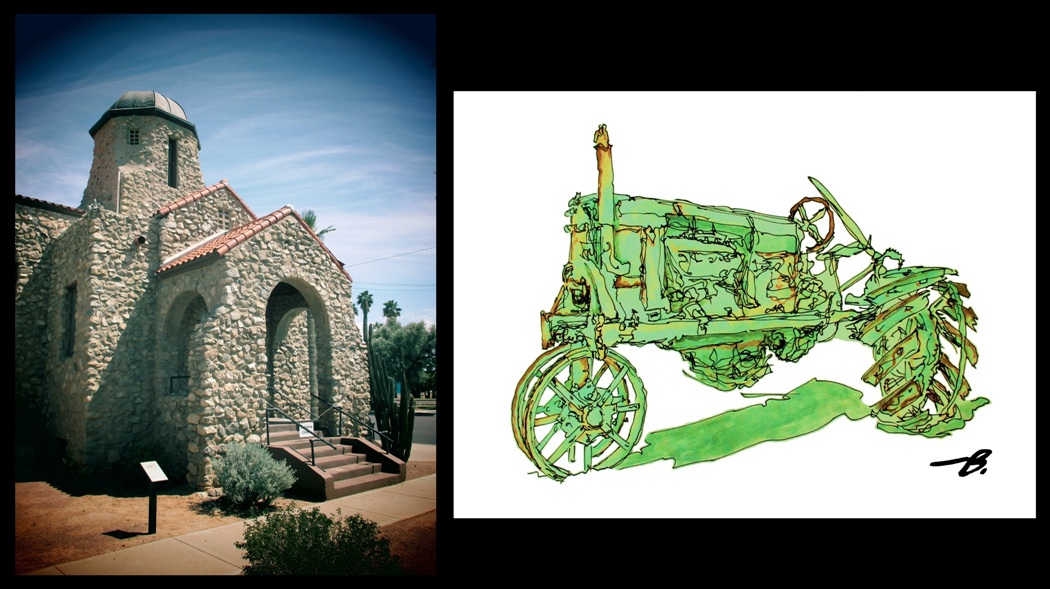
The Museum of Casa Grande, Casa Grande, Arizona
Every time I swing through a new town, I try my best to learn a little bit about the local history. If you’re not going to put your travels into some sort of sensible historical context, then what’s the damn point of even going? Besides, I could certainly use a reprieve from this scorching sun that’s chafing the skin on my arms and neck for a few minutes, and allow myself a little bit of air-conditioned creature comfort. The Museum of Casa Grande was just what the doctor ordered. Even better, it was just a few blocks from the skatepark kink-sink that just killed what little was left of my knees.
Casa Grande exists because somebody decided that it was high time to take a summer break. It’s true; I swear I’m not making this up. I’m staring at a sign in the museum that’s making all this abundantly clear and concise. They were building the Southern Pacific railroad from Yuma to Tucson when the summer started it’s usual desert sweltering. So some foreman somewhere decided to take a summer off, and resume construction the following fall, when things cooled off a bit back to “tolerable” levels. This is, after all, the Sonoran Desert, so that strategy seems more than sensible enough to me. The original name of the town was “Terminus”, as in “the end of the line”; it was only later that the railroad execs changed the name to honor the nearby Hohokam ruins. Casa Grande means “Big House” in Spanish, which is humorously sarcastic, considering that the town started life with only three buildings and five residents, and was nearly abandoned within twenty years of its settlement. Irrigation and agriculture were Casa Grande’s saving graces, and even today it’s the Cotton Capital of the world, populated by more dairy cows than you could ever count on a single road trip.


Red Rock Community Park, Red Rock, Arizona
Red Rock Skatepark is only open to the “official residents” of this brand-new, bustling housing tract way out in the middle of this former-farmland nowhere. The gatekeeper guardian is supposed to enforce this restriction, along with all the other rules on this long litany of fine print that’s outlined on an official-looking sign that’s riveted snugly to the solid steel fence. The problem is, I really can’t be bothered with reading this much blubbering bullshit in one standing.
Thankfully, the gate-guardian isn’t here to enforce anything right now. The gate is unlocked, and the door is swinging open and sqeaking in an extremely inviting manner. The only people around are the two little kids inside the park that are learning to push themselves around, and some sort of loud family-fun festival that’s happening a couple hundred yards away. Seeing an open opportunity to break a few rules and steal some fun, I casually saunter in as if I owned the place.
The pool is steep and deep. It’s between six to eight feet tall, and achieves true-vert status almost everywhere. The transitions are extremely abrupt, which jars the tired ‘ol knees mercilessly. But the coping has a shockingly smooth, almost buttery glide to it that contrasts with the harshness of the curved concrete. I climb out of the shallow end and walk all around the perimeter, examining the coping closely, and I swear I can’t find a ding, a dent, or a scratch on it anywhere. It’s as if the bowl was just poured and trowled yesterday. I look over at the kids playing in the corner with their bargain-basement skateboards, and I wonder why in the hell a housing authority would build something so massive, and so difficult and intimidating to skate, for little kids of such limited skateboarding ability.
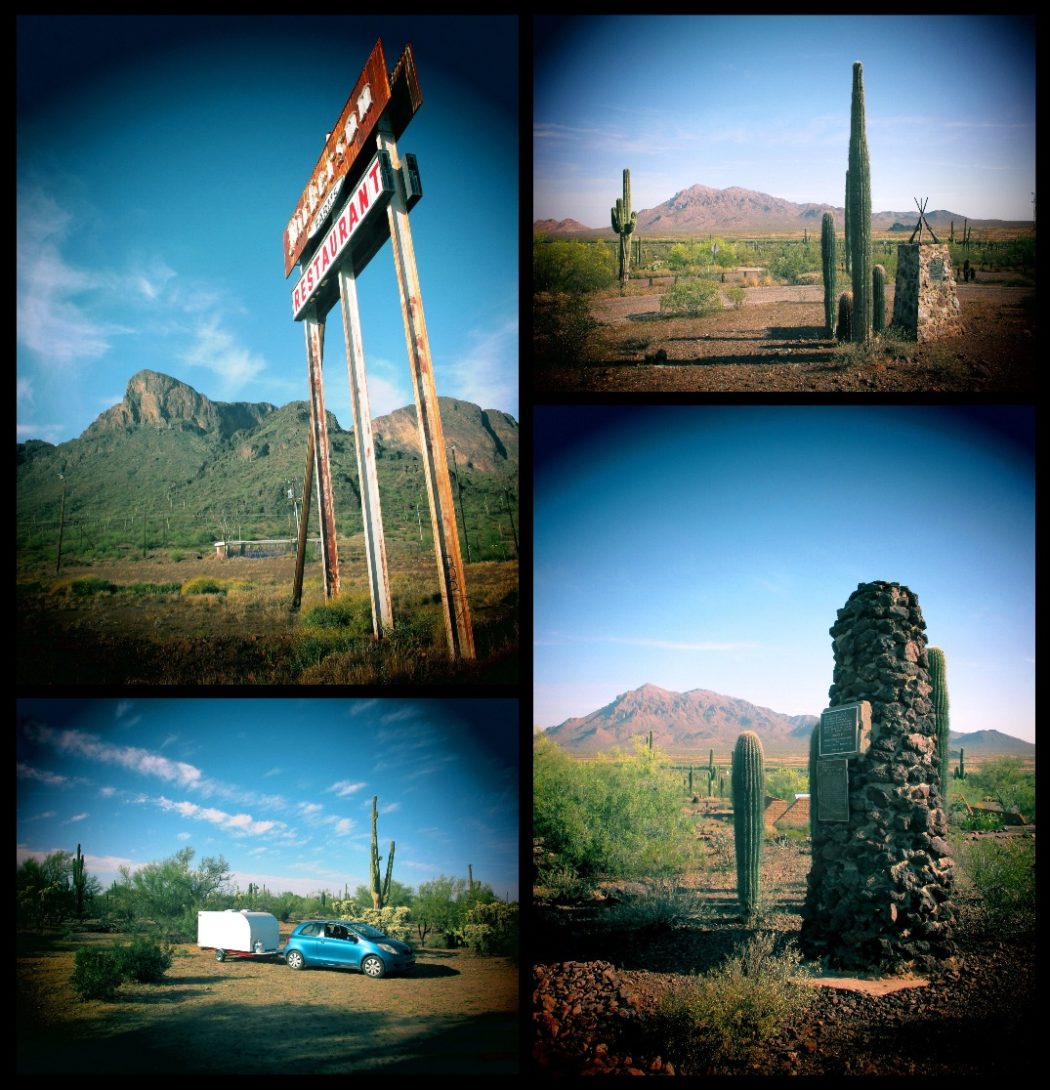
Clockwise from top left: Abandonment; Civil War Battle Memorial at Picacho Peak State Park; Battle of Picacho Pass Monument (for the Union dead); Cactus Forest Campground. Picacho Peak, Arizona
My campsite is about nine miles from the interstate. The interstate is about fifty miles from Tucson, and seventy miles from Phoenix. On my way to the campsite, there were road signs warning of “open range” conditions. Cows cavort freely out here, munching the miles away on their great journey to nowhere in particular. I’m not sure that you could get any further away from civilization, than I am right now.
Camping in the open moonlit desert is quiet, and creepy. Coyotes yip and yap close to the camper, loudly celebrating their kills in a manner that drives the fear of wild straight through my lonely heart. A whoo of an owl pierces the thin walls of my cozy little abode, while the light of the moon slices its way through the vents, casting sinister shadows that slowly but steadily march toward my sleeping-bag cocoon, silently advancing upon my sense of security, safety, and sanity. The temperature drops pretty precipitiously out in the desert once the sun settles in for the evening, and a quiet and comfortable calm rolls in a few hours later, immersing me in a deep and satisfying slumber. The hours tick by uninterrupted, all ten of them. I never sleep as soundly as I do in the cozy confines of my camper after a long and satisfying day of skating.
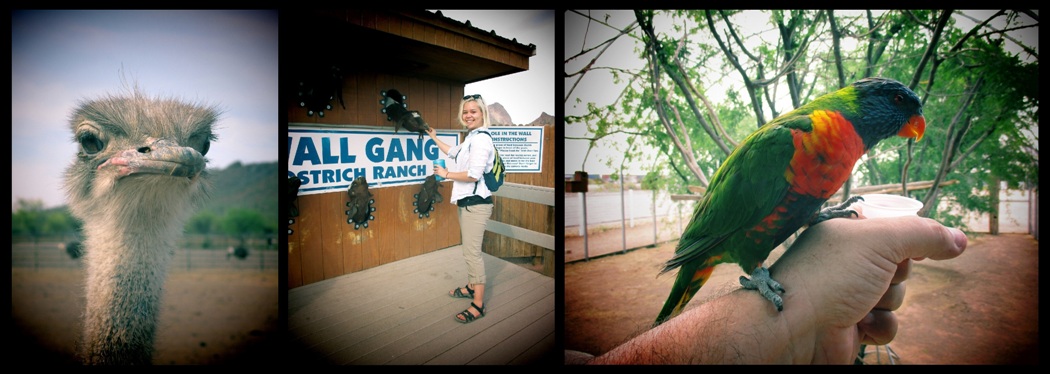
Rooster Cogburn Ostrich Ranch, Picacho, Arizona
There’s a sign in front of me that is quite clear in its intent. The Ostriches will bite, and Rooster Cogburn’s Ostrich Ranch is not responsible for accidents caused by your lack of a fear gear, your sense of high adventure, or your distain for cautionary common sense. I look at the Ostrich that’s almost exactly as tall (and heavy) as I am, and it looks back at me, straight-faced and waiting impatiently. In my hand are a few tidbits of green animal feed that resemble tiny bird turds. This is, after all, the stuff that bird turds are made of, so I’m rather amused (but not all that surprised) by the resemblance. Presently, I have two choices to choose from. I can dump the food down a small chute that empties in a feed bin, from which the ostrich can nip at its feed well away from my fragile fingers. Or, I can slowly hold the food out to the fence, and let the Ostrich crane its neck over, and peck the feed right out of the palm of my hand. The sign recommends slow and steady movements at all times, for all parties involved. However, it fails to point out that the Ostriches are really hungry, and they don’t read instructions very well. Slowly, steadily, he cranes his neck down, gently gesturing toward the pellets… and then, quite suddenly… snap! In a flash, three of my tasty little fingers are knuckle-deep in his blunt beak. It doesn’t really hurt all that much, but it does startle me fully awake. I decide to head toward the bunnies, instead. They seem softer, and far safer than I imagine the stingrays are going to be.

Skateboarding and urban exploration, naturally enough, have a lot in common. People that excel at sneaking into schoolyards and backyard pools, quite naturally tend to excel at sneaking in to almost anywhere. This former landing strip is becoming increasingly notorious for the over-enthusiastic tribal police that thoroughly enjoy terrorizing, arresting, and extorting trespassers that wander unawares onto the property. “Their property” is the former Williams Auxiliary Airfield #5, now known as “Gila River Memorial Airport”. What we’re supposed to be remembering out here in the boonies is far beyond me. The only things that exist out here are some long-abandoned runways and tarmacs that have since deteriorated back into the native sand and gravel, and a few long-forgotten Douglas DC-4 and Lockheed Ventura airframes that sit perched on their weak knees (or, in a few cases, square on thier tails) in sad states of gutted and graffitied dereliction.
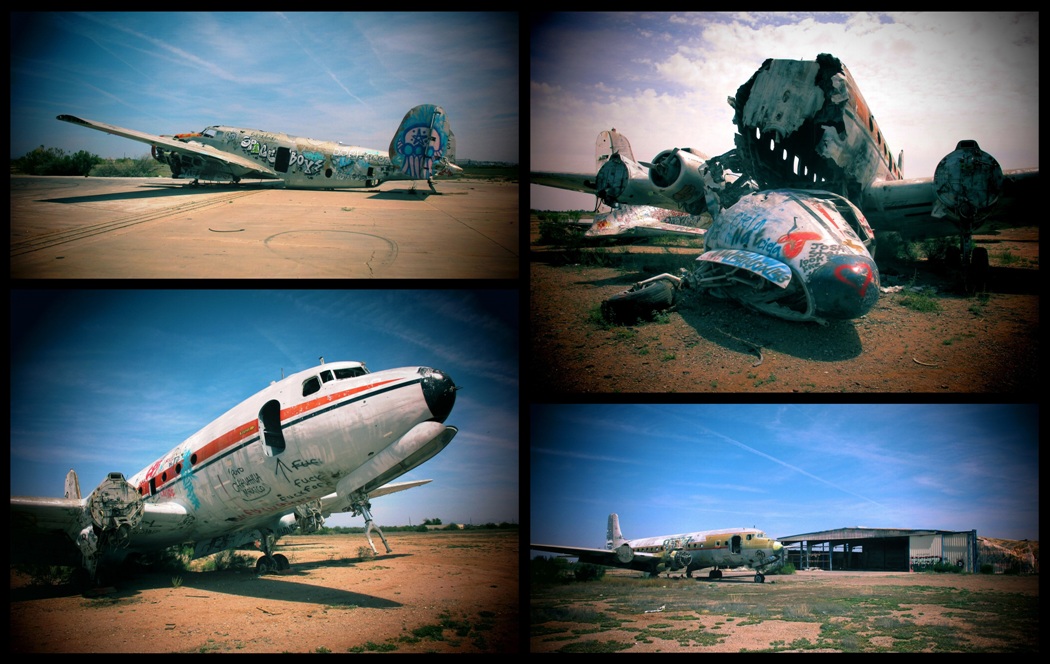
Abandoned airplanes at Gila River Memorial Airport (formerly Williams Auxiliary Army Airfield #5), Chandler, Arizona.
These few old airplanes, however, are fast becoming a powerful magnet for geocachers, visual artists, and urban adventurers. The motion sensors embedded at the entrance insure that the tribal police are on site to apprehend intruders within moments of some adventurous punk penetrating their prized property. Because they have the legal authority to immediately seize assets and impound vehicles as “evidence”, it’s probably a pretty steady and reliable revenue stream for the tribe’s overlords. One that they are surely quite keen on perpetuating, so long as less enlightened intruders are stupid enough to roll (or stroll) right through the main gate. The trick, it seems, is to avoid that main gate at all costs; to not bring too many valuables with you; and to park far away from the reservation perimeter, and well out of their jurisdiction.
Now, I’m not saying that I did any breaking and entering this weekend. Oh, no, not me! The Magazine certainly doesn’t condone these sorts of shenanigans, and neither do I. All I’m saying here, is that I somehow scored some really well-composed and colorfully saturated photos of airplane abandonment on my way home from my skateboarding misadventures this weekend, and I think they came out pretty damned spiffy. Nothing more, and nothing less. -B.

Summer Camper Tour 2016/17, Report Number Nine: Maricopa and Casa Grande, Arizona
This article was first published at the Concrete Wave Magazine website on May 3rd, 2017. Thanks again, Mike. -B.
